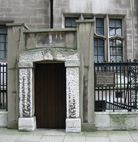
Some London Prison sites
Gateway from Tothill Bridewell re-sited at Middlesex Guildhall
|
BEHIND BARS Some London Prison sites Gateway from Tothill Bridewell re-sited at Middlesex Guildhall |
| london-footprints.co.uk |
Have you read of London prisons such as Bridewell and the Fleet and wondered where they were? The chances are that you have walked past their sites without realising as walking northward from Blackfriars to Mount Pleasant there are eight locations where you could have found yourself behind bars at sometime in the past.
On the west side of New Bridge Street between Tudor Street and Bride Lane stood the BRIDEWELL which was to give its name to other similar institutions. It was originally a Tudor Palace but was given by Edward VI to the City for use as a prison and workhouse. The present building on the site has a keystone depicting Edward and a plaque recording its former use.
The LUDGATE in the city wall stood immediately west of St. Martins-within-Ludgate Church. As with other city gates it was demolished as a traffic hazard in 1760 having served as a prison from the late 14th century.
The FLEET was the first purpose-built prison and operated from soon after the Norman Conquest until Victorian times. It stood on the east side of Farringdon Street between Old Sea Coal Lane and Old Fleet Lane and until the 1730s would have been on the bank of the Fleet River. The site is undergoing redevelopment.
Another notorious prison, NEWGATE, existed until 1902 when it was demolished for the building of the Central Criminal Court where some of the stones were re-used. It, like Ludgate, had begun as a gatehouse prison and it was from here that Jack Shepherd famously escaped having been chained in a third floor cell.
|
Across Newgate Street stands the Viaduct Tavern, a Victorian pub where old cells in the basement serve as storage areas. Behind this on a site redeveloped for Merrill Lynch stood the GILTSPUR STREET COMPTER, marked with a plaque. This was a sheriff’s prison designed by George Dance in 1791. |
| Snow Hill and Farringdon Road lead up to Clerkenwell Green and the OLD MIDDLESEX SESSIONS HOUSE. Now serving as a Masonic Centre, its courts were used until the 1920s. The basement cells, including a condemned cell, are now in use as a bar area and can be glimpsed through windows on the south side. It has two ghosts from its past history. |
|
Around Clerkenwell Close the former Hugh Myddleton School, which has been redeveloped as apartments, was built on a prison site and basement cell areas remained below the playground. There was a central hall and wings to the west, north and east of this were for male prisoners. The wing to the south was administration and the range running along the south was for female prisoners. Until 2000 these were open to view as the CLERKENWELL HOUSE OF DETENTION. As a remand prison it was London’s busiest between 1846 and 1878. After sentence prisoners could be sent to nearby Coldbath Fields.
COLDBATH FIELDS gets its name from springs, reputed to have medicinal properties, which operated in the 18th century. The fields were subsequently used as a rubbish tip known as 'Mount Pleasant'. In 1790 the site was cleared for the Middlesex House of Correction, opened in 1794. This was later known as Cold Bath Prison then Clerkenwell Gaol. Its harsh regime included working a treadmill that did nothing more than turning some sails. Originally a criminal jail it became a debtors prison before closing in 1885. In 1887 the Post Office adapted the treadmill houses as a parcels office, convenient to the railways. The old prison site was transferred to the Post Office in 1889 and its buildings were gradually replaced. The prison gate was however incorporated into a new sorting office building and remained until 1901. The last sections were demolished in 1929 for an extension of the Letter Office. The Royal Mail Archive on the site has more information [website].
Next time you are in the City perhaps you would like to walk this trail and view the sites of prison history from the Conquest to Edwardian times.
london-footprints.co.uk 2006